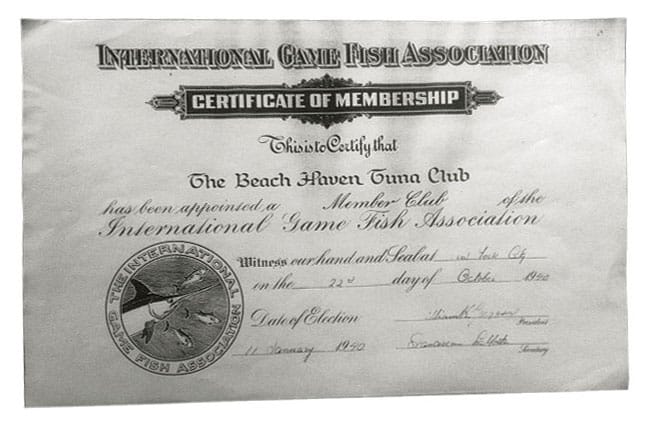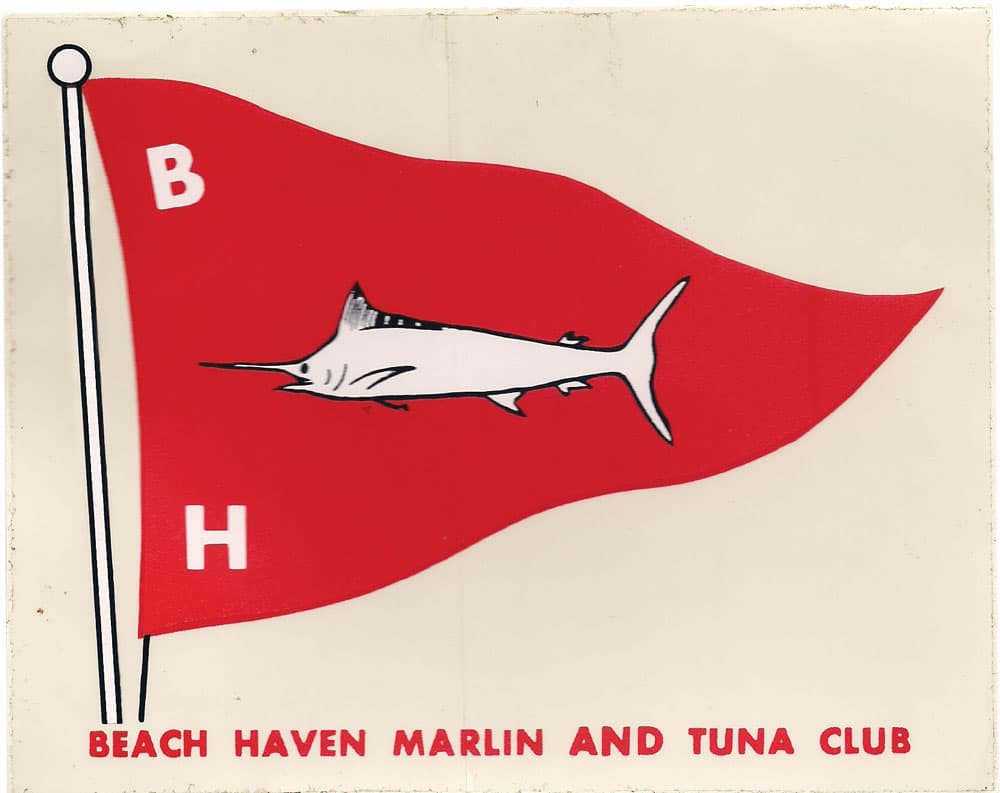
In fall 2012, Superstorm Sandy swept up the entire East Coast with gale winds, flood tides and monstrous seas, and the predictions of a devastating landing in New Jersey came true. Once the storm made its left turn into the barrier islands of uninhabited Little Beach and Holgate on the south end of Long Beach Island, its northern quadrant packed a crushing blow to the lower two-thirds of LBI. It was especially brutal to Holgate and my hometown of Beach Haven. Along with all the destruction to homes, marinas and boats, one of the oldest fishing clubs on the coast suffered a total loss to its facility, which was built in 1962.

A group of fishermen who had long fished the area founded the Beach Haven Marlin and Tuna Club in 1949 after they recognized the need and benefit of forming a club. Since the mid-1800s, Beach Haven was well-known for its prolific inshore bay fishing for weakfish, fluke, stripers and croakers. The Philadelphia and New York papers regularly documented this excellent fishing in the summers as well as the considerable water fowling in the winters.

As the summer homes and cottages of the Philadelphia gentry sprang up, the Beach Haven Yacht Club, founded in 1882 by a group of captains, began hosting what was to become the largest charter fleet on the East Coast, with well over 40 boats in service at its peak in the decades leading up to World War II. These boats were owned by some of the best skippers on the coast, several of whom will be the first to migrate south to Florida for the winter to pursue sailfish and marlin.
Prior to the founding of the BHMTC in 1916, Abercrombie & Fitch hired a fellow named William Baxter to head up the tackle department for them. While in that position, as a promotion to sell more tackle and promote the sport, he organized the founding of the Beach Haven Tuna Club through a merger with the Beach Haven Anglers Club and the New Jersey Fishing Club. This newly formed club was the first member club of the then-fledgling International Game Fish Association.

Membership was by invitation only, and the list of members who regularly fished Beach Haven included angling greats and well-known artists of the day, such as Kip Farrington, Francis Low, Zane Grey, Michael Lerner, Ernest Hemingway, Van Campen Heilner, Philip Wylie, Harlan Major, Lynn Bogue Hunt, George Le Boutelier, William Mackey and Carl Fisher, who later became known for extensive real estate developments in Florida and Montauk, New York. He also served as the chairman of the board of Ashaway Line, as well as other prominent manufacturers.

By 1912, some of the skippers had power vessels and began fishing offshore, including a young -pioneering captain named Tom Jones, aboard Miraamy. He brought the first bluefin tuna to the dock around 1915; by 1922, he had developed trolling techniques to target with regularity the prolific schools of tuna he found at places like the Barnegat Ridge, with white marlin being an “accidental catch.” Captains Rudy Steinhauser of Blackjack, and Max Schoenberg, with sons Hennie and Herb, on their boats Spearmaiden, Henrietta and Cadet, also pioneered the offshore grounds and traveled to West Palm Beach and Stuart, Florida, in the winters to charter there.

During this time, fishing with the skilled Beach Haven skippers, Baxter developed and patented the first shoulder harness. He also developed the fish flags we know today, which announce a day’s catch, and he imported the first Japanese feather to the tuna fleet of Beach Haven. He persuaded well-known celebrities to sample the area’s great fishing, including Babe Ruth and Lou Gehrig; on one such trip, they were held to the dock with a hard nor’easter, so they “… imbibed heavily of spirituous liquors, and the Babe was given an egg shampoo on the yacht club dock.”
Baxter held the annual club banquet at swank hotels of the day in New York City, including the Hotel New Yorker and St. Regis. With World War II basically shutting down sport fishing off the coast, the Beach Haven Tuna Club became dormant during the war and it was totally inactive in 1950. The seeds for the Beach Haven Marlin and Tuna Club were sewn.

The First Blue
Prior to the war, in summer 1938, the charter fleet had been experiencing good catches with tuna, some mako sharks, and white marlin with some frequency. Then Capt. Watson “Kinky” Pharo, aboard his charter boat Eleanor, captured the first blue marlin off New Jersey on a Japanese feather, bringing the fish to gaff after an hourlong battle. The excitement for the charter skippers and the huge crowd who gathered put another spotlight on Beach Haven as a fishing hot spot. Then the war came, and things changed.
When the war ended, people once again began fishing. In 1949, a group of 27 fishermen drafted a new charter for the Beach Haven Marlin and Tuna Club, holding meetings in the storied Acme Hotel and Bar on the bay at Dock Road in Beach Haven, site of the Ketch Restaurant today. The group included South Jersey legend H.T. “Piney” Parker of the boat ABC; Al Sturch, a prominent angler and member of the Atlantic City Tuna Club; then-commodore Robert Hutt; and Capt. William Howe of the charter boat Augusta, among others. The club flourished, and private boats replaced the famed charter fleet of the Beach Haven Yacht Club. The club quickly built up an active membership with their annual inter-club fishing contest for local species known to frequent the area throughout the seasons.
There were five basic purposes of the club at the outset: To promote a closer relationship between various sport-fishermen; to further efforts to obtain outstanding publicity for Beach Haven and Long Beach Island; to provide a means for getting prizes together for deserving contenders; to encourage participation in various tournaments and fishing contests; and, finally, to work for and uphold fishing conservation and to promote a high degree of sportsmanship among saltwater anglers.

By the end of the 1950s, the club meetings at the bar tended to get a bit spirited; the need for a house of their own at which to meet became a major drive for several members. In 1961, Dick Ryon, owner of the boat Anthracite, became commodore and formed a nonprofit corporation as a holding company, which issued bonds to raise the money to build the building on land donated by members Capt. William Howe and Jim Priestly, who both owned marinas in town.
Through the hard work of members and committeemen, the first clubhouse was completed in 1962 and became the focal point of club activities. With a large kitchen, an ample private bar and a large room for events, the facility was well-used. To make seating for the room, upscale varnished wooden chairs were sold as a fundraiser to members, and their boat name was painted on the backrest of the chair like a transom. It was always a sight to enter the room and read the names of the boats. Many of the chairs got damaged by water in Sandy, and, unfortunately, those members who supported the club back in the day have lost that monument to their boat and their participation in the club.
By 1974, the BHMTC Holding Company could write deeds and turn the property over to the club with deed restrictions and the specificity of the stockholders’ original intent to keep the club a place for sportsmen and not a commercial enterprise.

In 1970, the club held its first White Marlin Invitational Tournament. Club member and captain Joe Bossard, who ran Bob Gaskill’s Bee Dee, was the moving force behind starting the event. With a nice clubhouse, good fishing, excellent hospitality, good meals each night and camaraderie among participants, it soon became a popular event. The tournament flourished with visiting boats coming from up and down the coast to fish alongside the formidable fleet of club members. These members included Don Leek of the boatbuilding family on Wild Duck; Walt Johnson, a driving force in marinized diesel engines on J&T; Parker’s ABC; and Ryon’s Anthracite. Back then, the boats all followed a local boat down the bay; each morning, crowds gathered on the street ends to watch the parade of boats leaving, then went to the clubhouse to watch the weigh-in.

Today, like most tournaments, the White Marlin Invitational Tournament has a flat fee of “pots” for winnings, but in the original days of the tournament up to the mid-80s, a true calcutta was held at a member’s house to auction off each boat. This was one of the more social things lost in the drone of fishing for money in many of today’s tournaments. The only tournament I know of that still has a real calcutta today is the big show down in Texas, Poco Bueno. The White Marlin Invitational Tournament is still fished today, and it’s one of the oldest white marlin tournaments on the coast, predating Ocean City’s mammoth White Marlin Open by four years.
As is the case with many clubs, membership changes; for a period in the ’70s and ’80s, the club had more social members than fishing members, but today, fishing participation is as high as ever. After Sandy, the original building had to be demolished, and the members rose to the occasion, building an incredible new three-story facility on the original property with a large expansive room to serve functions, a second-story bar, and outside decks overlooking the bay.

Along with the White Marlin Invitational Tournament, the club now hosts the Beach Haven LBI Cup Striper Invitational, which has become a staple in many angler’s fall fishing schedule during the striper run. Inter-club events include the spring striper and bluefish tournament, the mako and tuna tournament, an inshore bay tournament, the first offshore tournament of the season, a men’s, women’s, intermediate and junior’s tournament, the overnight offshore tournament, a fall striper tournament and a wreck tournament. The annual fishing contest has been in place since the club’s inception, recording catches throughout the year and awarding angler’s achievements at the annual banquet for largest fish of the species.

One of the hallmarks of the club is their Junior Angler membership. Today, the club has more youth participation than ever, hosting a junior angler event and encouraging the participation of kids in the annual fishing contest. As a former junior member, I remember attending the awards dinners and receiving prizes for my catches, including rods, tackle boxes, lamps and a host of other things that kept my interest in fishing at a time when there were so many things to divert that attention.
There are many great and well-known fishing clubs, but few with such a clubhouse, a storied past and an active membership. For more than 65 years, the club has served the membership and played an active role in promoting fishing in the area. It has been supportive of many recreational fishing conservation issues, and it has hosted a long-standing white marlin event that has seen some of the sport’s top professionals fish it over the years. Always a fixture on the coast, the Beach Haven Marlin and Tuna Club was founded and sustained by avid fishermen with a desire to grow the sport and share it among friends, and that same philosophy is still entrenched in today’s membership.







